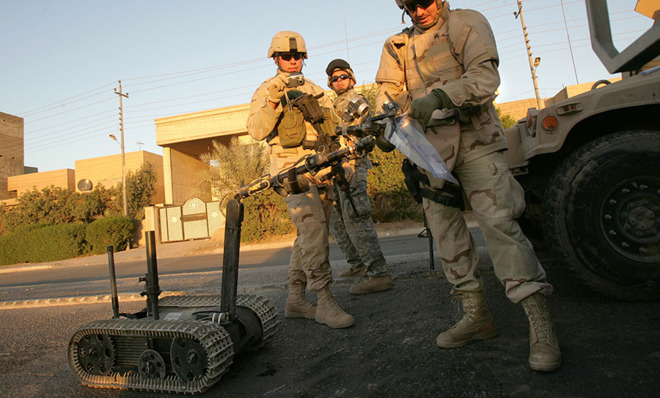The mechanized future of warfare
The military is developing robotic soldiers, planes, and ships that may not need a human to guide them

How advanced are today's weapons?
Modern soldiers are equipped with a wide array of highly sophisticated, computer-enhanced weapons systems that would have been unthinkable just a generation ago. About 40 percent of the U.S. aerial fleet consists of unmanned combat drones, and the Air Force now trains more drone operators than bomber or fighter pilots. Robotic ground vehicles have also flooded the battlefield, with more than 6,000 deployed in Iraq and Afghanistan to haul gear, climb over obstacles, and provide advanced reconnaissance. The military is now testing a more advanced version called a Legged Squad Supports Systems robot that looks like a mechanical mule, and can carry 400 pounds of cargo over uneven terrain. With even more futuristic devices in the pipeline, some officials are estimating that up to 25 percent of infantry forces could be replaced by robots in the coming decades. Like aerial drones, most of the current systems are operated by remote control, but experts say some devices will soon be capable of carrying out designated tasks with minimal human oversight.
What will the next generation look like?
The Week
Escape your echo chamber. Get the facts behind the news, plus analysis from multiple perspectives.

Sign up for The Week's Free Newsletters
From our morning news briefing to a weekly Good News Newsletter, get the best of The Week delivered directly to your inbox.
From our morning news briefing to a weekly Good News Newsletter, get the best of The Week delivered directly to your inbox.
This summer, the Navy began testing unmanned patrol boats that can escort and defend warships traveling through hostile waters. Adapted from NASA's Mars rovers, these boats are programmed to move in sync with other vessels, select routes, and avoid obstacles without a human at the controls. This summer, the Air Force unveiled the X-47B, a stealth-enabled drone capable of taking off, flying, and landing on an aircraft carrier without the assistance of a remote pilot. Micro drones that can work together like a swarm of deadly bees are also in the works, as is a fully autonomous humanoid robot that could someday go into battle in the place of a human soldier (see below). "An autonomous weapons arms race is already taking place," says Steve Omohundro, an artificial-intelligence expert at Self-Aware Systems in California.
Will there be killer robots?
Most experts say the deployment of fully autonomous weapons systems is at least five years away, but others contend early versions of them exist. Britain's Brimstone missiles, for example, can distinguish while in the air among different types of targets, such as a car, bus, or tank, and can choose among those targets without human oversight. The Israelis' Harpy drone, which was deployed over Gaza this summer, patrols a given territory searching for enemy radar signals, then fires on the source of those signals entirely on its own. Since 2006, South Korea has deployed "robotic sentries" along its border with North Korea. The stationary robots ask any person who comes into range for a password. If the wrong answer is given, the robot is capable of opening fire on its own, but South Korea says that decision still rests with a human operator.
(Want more in-depth briefings? Try 4 risk-free issues of The Week magazine.)
A free daily email with the biggest news stories of the day – and the best features from TheWeek.com
Will humans always be involved?
No country is openly developing fully automated weapons systems designed to target humans. But since such weapons are technologically possible, many fear their development is inevitable. The Campaign to Stop Killer Robots, launched in 2013 by Human Rights Watch and several other nongovernmental organizations, hopes to make such weapons illegal under international law. These activists argue that artificial intelligence, no matter how advanced, will never be capable of effectively distinguishing between combatants and civilians. They also contend that it is fundamentally immoral to give machines the power to make life-and-death decisions, and that using robots in combat will make it too easy to go to war. "War without reflection is mechanized slaughter," says Christof Heyns, the U.N.'s Special Rapporteur on extrajudicial killings. "If there's ever going to be a time to regulate or stop these weapons, it's now."
Does everyone agree?
No. Some advocates inside the cyberworld contend that lethal autonomous weapons would be faster and more efficient, and cause less collateral damage than human-operated systems. They point to the advances in computing, artificial intelligence, and robotics that have already revolutionized a wide array of industries, from manufacturing to finance to medicine, and maintain that there is no reason to prevent those technologies from being applied to military operations. These new systems will be "less emotional, more selective, and able to provide force in a way that achieves a tactical objective with the least harm," says Samuel Liles, professor of cyberforensics at Purdue University.
Where do we go from here?
Everyone agrees that robotic planes, weapons, and soldiers will play an increasingly important role in warfare. Even if a global ban were attainable, it would do nothing to prevent rogue forces from pursuing these weapons. Advocates say it is therefore imperative that the U.S. take the lead in developing these weapons or risk falling behind in what is likely to be the most important arms race of the 21st century. Human rights advocates, however, say the U.S. should take the lead by campaigning to ban any weapon that is not fully under human control. Otherwise, "we may find ourselves on the other side of a line," Heyns says. "And then it is very difficult to go back."
The Terminator in development
At 6-foot-2 and 330 pounds, the U.S. Army's new Atlas robot just might give Arnold Schwarzenegger a run for his money. First unveiled in July 2013, the humanoid robotic soldier from Boston Dynamics is meant to be a first responder in times of crisis, and is designed to withstand harsh environments — like the inside of a nuclear reactor in meltdown — that human soldiers can't. Walking upright on two legs and equipped with "articulated, sensate hands," Atlas can turn knobs, manipulate tools, and yes, fire machine guns. Last month, developers showed off its remarkable dexterity by having it mimic the workout routine made famous in The Karate Kid. Atlas is still tethered to an external power supply and relies on a human controller to dictate commands, but as advances in battery power and artificial intelligence continue, that will change. "If you would like to create a Terminator," says roboticist Ronald Arkin, "keep doing what you're doing."
-
 Zimbabwe’s driving crisis
Zimbabwe’s driving crisisUnder the Radar Southern African nation is experiencing a ‘public health disaster’ with one of the highest road fatality rates in the world
-
 The Mint’s 250th anniversary coins face a whitewashing controversy
The Mint’s 250th anniversary coins face a whitewashing controversyThe Explainer The designs omitted several notable moments for civil rights and women’s rights
-
 ‘If regulators nix the rail merger, supply chain inefficiency will persist’
‘If regulators nix the rail merger, supply chain inefficiency will persist’Instant Opinion Opinion, comment and editorials of the day